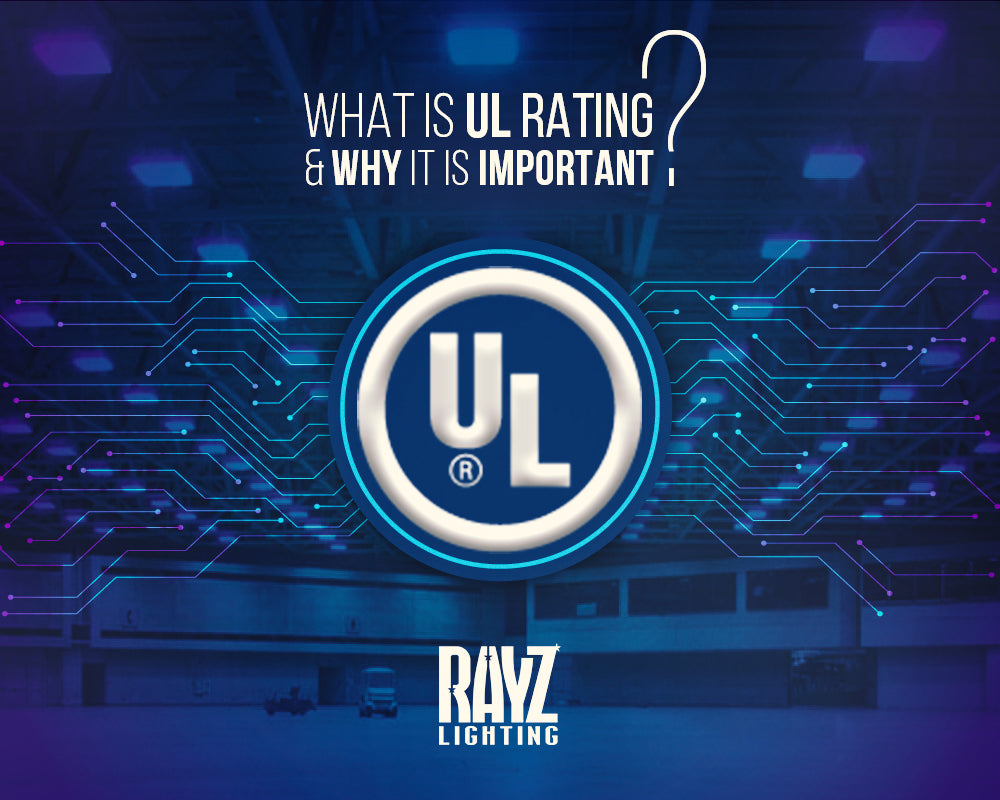Everything You Need to Know About UL Rating Lights - From UL Certified to Listed & Top Fixtures!
RECENT POSTS
-
 Fri, Mar 17, 23
Fri, Mar 17, 23 -
 Fri, Feb 24, 23
Fri, Feb 24, 23 -
 Thu, Feb 09, 23
Thu, Feb 09, 23 -
 Mon, Jan 30, 23
Mon, Jan 30, 23
TAG CLOUD
- Benefits of Flood Lights
- best led flood light
- commercial ceiling lights
- Commercial Lighting
- FAQ
- high bay lighting solutions
- High Bay Lights Motion Sensor
- How does the Motion Sensor Work?
- Importance of LED
- Indoor Lighting
- Industrial LED Light Fixture
- LED
- led flood light lumens
- LED Football Stadium Light
- LED Gym Lighting
- LED High Bay Lights
- LED Light Connecticut
- LED Light for Food Processing Plant
- LED Lighting
- LED lightings
- LED lights
- LED Street Light Vs. LED Parking Lot Light
- Lumens vs. CRI
- outdoor flood lights
- Outdoor Lights
- Rayz Lighting
- Rebate
- Retail Stores
- Stadium Light
- Temperature vs. Lumens
- UFO High Bay Lighting
- UFO High bay lighting for Warehouse
- Warehouse
- warehouse lighting

Electrical equipment, especially lights, have experienced immense advancement in functionality and fixtures in recent times. Lighting sectors have emerged as the most profitable business offering various LED lights in different segments and categories to fulfill the demand and supply of the market.
It's a no-brainer that lights come with specialized types with a brand or logo as a remark of quality they belong. So, whenever consumers purchase lights for their home, office, or factories, they tend to buy those gadgets based on the brand they refer to: but, they forget to check the ratings and other important information compared to the brand name.
Generally, LED light comes under the UL Rating category, and many of us have no idea what that is? What does UL rating mean, and how important is it to buy UL-rated lights?
See, purchasing LED lights for your establishments is not a complicated task, but which one topurchase is indeed demand a little bit of knowledge and information for sure.
So, What is UL Rating Lighting?
Before dive into the UL rating lighting information, let's first understand the true meaning of the two letters UL, which refers to Underwriters Laboratories. It is an independent organization committed to product testing and certification.
The ultimate regime of this organization is to test lights and their fixtures, ensuring their malfunctions and hindrances.
Although there are millions of light manufacturers, not all go under the UL rating lighting testing, and those who do, rated as UL listed lighting ready to serve its purpose safely.
So, next time, while purchasing a LED light, make sure to check the UL rating lighting mark to find out whether the light comes under UL listed lighting or not.
What is UL Rating for Lighting Fixtures?
The above elaboration is to help you understand the meaning of UL and its working curve. As we all know, electricity has become an integral part of our daily lives; manufacturers have started to develop LED lights for all locations, including dry, damp, and wet areas and categories.
To make it easy for people to purchase the correct order LED light, UL tested the lights and specified them into the relevant categories, whether suitable for dry, damp, or wet areas.
This should help you differentiate between UL rating lighting and UL tested lighting in the best ways possible.
UL Rated for Dry Locations
Any lighting equipment used indoors far from wet conditions comes under this category. Such lights are common to us all and available easily on any electronic shop. Usually, you will find the information on the container under the UL-listed lighting category. The word "Yes" clearly indicates that the product inside is UL rated for dry locations.
These lights are energy-efficient, durable, and cost-effective. In contact with heavy damp might lead to spark that can cost massive damage. However, slight water drops or moisture won't cause much to the surroundings.
UL Rated for Damp Locations
Dampness belongs to the sub-category of wetness, and it can be counted as both indoors and outdoors locations. LED lights UL rated for damp locations can be recognized in the container UL listed lighting category.
For example, the LED lights installed in your bathroom and the steam room come under UL rated for damp location categories. While manufacturing LED lights referencing damp locations, manufacturers add extra features to make it safe for the users.
UL Rated for Wet Locations
Whenever you see the remark "suitable for wet locations" on any lighting equipment container, ensure listing that in the UL rated for the wet location category. Such lights are designed with advanced features that resist direct splashing water and remain ineffective.
You can see such lights on docks, close to bathroom showers, near pool areas, etc. Also, you can use UL-rated wet location lights on damp locations as well.
Difference Between UL Certified and UL Listed
So far, you indeed have a clear idea about what they do and their procedures. A UL certified lights need to meet the following standard process: features, raw material used, sizes, and many other details. Once a LED light gets a tag of UL certified lights by the Underwriters Laboratories, it is now 100% safe to use.
UL-listed products undergo more tests and examinations than UL-certified products. Here, the Underwriters Laboratories listed on the product whether they belong to dry, damp, or wet categories. While listing, they mainly focus on the safety and sustainability of the product before making it a UL-listed product.
Hopefully, the above information will end the UL listed Vs UL certified discussion and help you classify the vital difference between UL certified and UL listed lights. Both belong to different processes and categories to make consumers' purchases easy.












